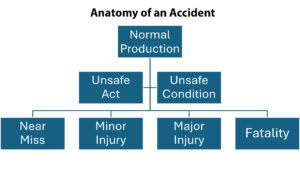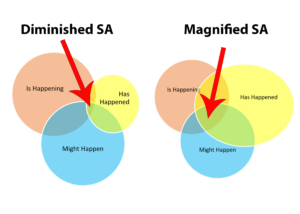Question: Which professional football player is the greatest of all time (GOAT)? Before someone says Tom Brady, let me tell you the correct answer is Earl Campbell. Having grown up in Houston, Texas, and watching him run, trust me. He also makes fantastic hotlinks. Okay, there could be some debate; his coach, Bum Philips, was once asked if Earl is in a class of his own, answering, “I don’t know if he’s in a class by himself, but I do know that when the class gets together, it sure don’t take long to call the roll.”
The GOAT is a topic of discussion in all walks of life, so what is the GOAT accident prevention principle? First, what is an accident? An unplanned event (extremely important since planned events are called insurance fraud) and an unforeseen event resulting in bodily injury and/or property damage.

Accidents occur at the intersection of normal production, unsafe conditions, and unsafe acts, resulting in one of four possible outcomes: a near miss, minor injury, major injury, or fatality. Failure to manage unsafe acts and/or unsafe conditions leaves the outcome to luck. Unsafe acts drive the bus! Depending on the expert, unsafe acts are the driver in 70-90% of all injuries in the workplace.
Unsafe acts are driven primarily by a lack of recognizing one’s surroundings – situational awareness (SA). SA comes down to three basic questions: what has happened in the past, what is happening right now, and what might happen in the immediate future – where those three questions coalesce is the home of SA.
Failure to grasp or ask any of those three questions diminishes one’s SA. If your employee doesn’t understand what has happened in the past, his SA is lessened! Conversely, employees who understand and ask those three questions have a heightened SA. An employee’s SA is directly proportional to their grasp of what has happened, what is happening, and what might happen in the immediate future.

For example, consider linemen who regularly working 45+ feet in the air. Fear of heights is the fourth greatest fear in America. Why? Because gravity sucks, and it always works. Linemen are fully aware of what could happen if they are suddenly no longer anchored to the pole, thus heightening their SA. BTW, an unanchored lineman 45’ in the air will make contact with the earth in 1.6725 seconds traveling at 36.69 mph.
Situational Awareness is the GOAT of accident prevention principles. Failure to grasp what has happened in the past, what is happening right now and what might happen in the immediate future puts you and your employees in a most precarious situation.
*The views and opinions expressed in the Public Risk Management Association (PRIMA) blogs are those of each respective author. The views and opinions do not necessarily reflect the official policy or position of PRIMA.*

By: Ed Pratt
Director - Risk Services; Safety National
Summary of Qualifications
Certified safety professional with 43 years of experience
Responsibilities
Improve profitability by reducing customer's accident frequency and severity.
Business Experience
Forty-three years of experience working for multiple insurance carriers, including Safety National for 21 years.
Professional Affiliations
American Society of Safety Professionals (ASSP)
Education
B.A. Biology with a minor in Chemistry, University of Mary-Hardin Baylor



